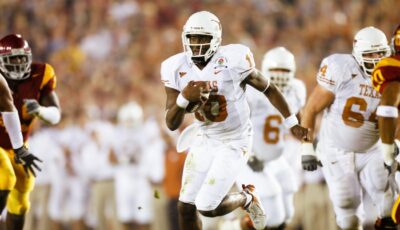
Tennessee football: 5 things to watch surrounding the Vols’ defense in 2021
It’s been a tumultuous last 9 months on Rocky Top, but the Orange & White Game was at least full of fireworks Tennessee fans could actually celebrate.
Vol Nation got a glimpse of the potential offensive renaissance under new head coach Josh Heupel, with their final spring scrimmage chalked with plenty of points, yards and explosive plays.
Despite a roster that’s been decimated by departures since the firing of former coach Jeremy Pruitt, the spring ended with those around Tennessee feeling a bit more optimistic about the program’s direction under Heupel’s stewardship.
The ingredients are there for Heupel to do something fun on offense, a notion I examined in a piece recently, but it might be problematic on defense in 2021.
Some games could get real ugly.
So with that fun teaser, here are 5 things to watch (and know) surrounding Tennessee’s defense this fall.
1. Who’s still left in Knoxville, exactly?
Whether it was via the transfer portal (LB Henry To’o To’o, LB Quavaris Crouch, OLB/DE Deandre Johnson, DL Emmitt Gooden, DL John Mincey, LB JJ Peterson and DB Key Lawerence, among others), the NFL Draft (CB Bryce Thompson) or dismissal (OLB/DE Kivon Bennett), Tennessee’s defensive depth — and talent-base — was gutted this offseason.
The Vols lost their best overall player (and leading tackler) in To’o To’o, their top 2 pass rushers and sack leaders, their No. 1 cornerback and several depth pieces that figured to be factors in 2021.
There are still some players for new defensive coordinator Tim Banks to work with (more on that later), but the quality depth at multiple spots is dangerously thin, especially at linebacker, impact pass rusher and corner. I’m not sure you would label a single unit as above-average to good, either.
Ultimately, to even field a functional defense for a full 12-game season this fall, Tennessee is going to need good fortune in the health department.
2. The defensive line must lead the way
The one place depth isn’t an issue is up front. Pruitt left Heupel with plenty of 280-300+ bodies to fight with in the SEC.
Now, it’s simply on the new staff to get the most out a group that’s largely underachieved for several seasons.
In 2020, Tennessee rotated as many linemen (10) as the unit combined for tackles for loss (10) all year.
Heupel inherits a group with 8 defensive linemen with starting experience (70 career starts among the unit) and plenty of others who have seen rotational snaps.
The unit has a slew of former blue-chip recruits (Greg Emerson, Omari Thomas) and has 5 super-seniors (Aubrey Solomon, Darel Middleton, Latrell Bumphus, Ja’Quain Blakely and Matthew Butler).
But can they improve?
The Vols were steady defending the run last season (No. 5 in the SEC in yards per rush at 3.68), but the defensive line didn’t make many plays.
In fairness, part of that was by design. Pruitt’s scheme emphasized linemen holding their gaps and funneling clean lanes to To’o To’o and the other linebackers. But the Vols didn’t have many linemen “winning” a whole lot, either.
As I’ll touch on here shortly, the situation at linebacker is scary, so Tennessee’s defensive line better become much more involved in creating havoc (hurries, TFLs, sacks, etc.) in 2021.
Because…
3. The Vols are precariously thin at linebacker
By the end of spring practice, Tennessee was down to former 3rd/4th stringers, a couple of walk-ons and a long-snapper rotating at inside linebacker.
If this were Texas Hold’em, Heupel was dealt a Jack/2 from the start here. It is what it is … and that’s simply an untenable problem in 2021 barring multiple additions via the transfer portal.
Redshirt junior Jeremy Banks missed most of the spring due to shoulder surgery, but the former tailback likely enters the fall the presumed starter at inside linebacker, mainly because there isn’t a better option. Banks is a thumper and has showcased some playmaking ability, but he’s wildly inconsistent in pass coverage and doesn’t always play his assignments in the run game.
The well-travelled transfer Tennessee just added from Texas fits in this mold, too. Juwan Mitchell, a former JUCO transfer who led the Longhorns with 63 tackles in 2020, at least gives the Vols another solid body at the spot, but the 6-1, 230 pound is more of a 2-down ‘backer and struggled consistently in pass coverage at Texas.
The Vols are transitioning away from a base 3-4 scheme to a more 4-3, 4-2-5 look, so the mass exodus at the position is at least lessened some compared to the need for bodies a year ago. Still, the guys behind Banks and Mitchell — junior Roman Harrison, who was mainly recruited as an edge rusher, Morven Joseph, little-used senior Solon Page III or Aaron Willis, who was suspended all spring — have a combined 25 career tackles.
This is still a position group that’s desperate for another transfer this summer, but even then it won’t be a unit that engenders much confidence all season.
4. Where is Tyler Baron best suited?
Tennessee’s sophomore has perhaps the most raw talent among the team’s cast of defensive players, but Baron’s long-term positional fit remains in flux.
At 6-5, 255, Baron can play outside linebacker or defensive end, where he worked a lot with the starters this spring. He seems more comfortable with his hands in the dirt, but because the Vols have some options along the DL, is Baron best slotted as a standup linebacker?
Time will tell.
At a press availability earlier this spring, Banks addressed this situation with reporters, praising Baron’s talents and versatility but acknowledging they don’t have a good answer as to where to definitely play him.
“I think it is too early to say exactly how we are going to utilize him,” Banks said. “And, quite frankly, I think that is a good problem to have. He has a good skill-set, so we are still evaluating it, and hopefully by the end of spring, heading into fall, we will have a better idea.”
Ideally, Banks figures out a way to get Baron and newcomer Byron Young, a JUCO transfer hybrid outside linebacker who had a strong spring, on the field together as much as possible, giving a unit desperate for pass rush productivity as much juice as possible.
5. Tennessee’s best avenue to success = red-zone roulette
Opponents are going to constantly challenge Tennessee’s pass defense this fall, so limiting explosive plays and making teams earn it inside the 20-yard line is the best path forward for the unit to succeed.
Banks may want to coach aggressively, but Tennessee’s secondary was exposed plenty in 2020, and it lost its best player heading into a new season. The Vols ranked 11th in the SEC in pass defense and recorded just 5 interceptions — 3rd-fewest in the conference.
Although you can’t take too much at all from the spring game (the defense was missing a slew of likely starters and walk-ons comprised multiple second-team spots), the fact Tennessee’s offense shredded an iffy secondary wasn’t very surprising.
The best thing Banks’ unit can do in 2021 is play sound, simple football. Bend but don’t break … to oblivion. Gamble that you can get *enough* stops inside the 20 to remain competitive in most games.
The Vols were salty in the red area last season, highlighted by a huge stand to end the first half at Georgia. They finished No. 3 in the SEC in touchdown percentage (60.47), and they need to replicate that again this fall.
Notably, perhaps the most encouraging takeaway defensively in the Orange & White Game was the couple times the first-team defense did buckle down inside the 20 and force 2 short field goals.
Jesse Simonton is a college football writer who has covered the SEC previously for the Miami Herald, SEC Country, volquest.com and elsewhere. Follow Jesse on Twitter @JesseReSimonton.







